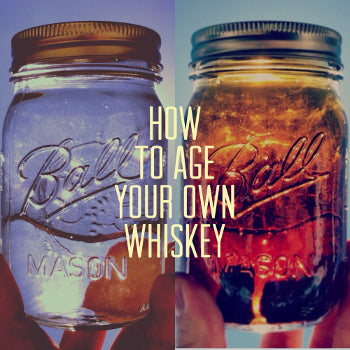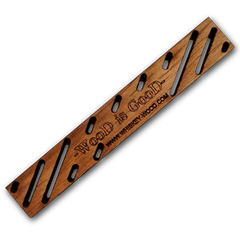This blog provides information for educational purposes only. Read our complete summary for more info.
How to Make Your Own Aged Whiskey
Barrel Aged Whiskey

Barrel aging offers many benefits. It is responsible for much of the flavor found in aged spirits. It also makes spirits much more palatable by removing some of the chemicals that make whiskey taste "hot" or "harsh."
To spot aged whiskey, all you need to do is evaluate the color of the spirit, which is easy to do since almost all whiskey bottles are clear. Aged whiskey can be golden colored to caramel, to dark brown.
The color of whiskey is confusing to a lot of people. You see, most folks think that "white whiskeys" are clear because they're made with a different process than colored spirits. That's only partially true. Yes, the typical recipes for all types of spirits vary, but the actual production process and ingredients are very similar, and in some cases, exactly the same.
Brown whiskey (everything from Jim Beam Bourbon to Jameson Irish Whiskey) comes off the still as clear as mountain spring water when it's initially produced. That's right, initially, all whiskeys look exactly like a white whiskey right out of the still. It isn't until whiskey is aged in wooden barrels that it takes on darker colors.
Why is Whiskey Aged?
Why is whiskey aged? Well, similarly to many other longstanding traditions, the practice of barrel aging grew out of necessity. Early producers and transporters of wine used wooden barrels to ferment and then ship their products. Though, the practice has withstood the test of time because, coincidentally, long term storage in barrels has a positive effect on the character and smoothness of most alcoholic beverages. Early consumers of these beverages noticed that (typically) the longer the beverages had been stored in barrels, the better they tasted. Thus, the demand for barrel aged wine and spirits was born.
What Happens During Aging?
During the storage period changes in temperature and humidity cause alcohol to be pushed into and sometime sucked out of out of the wooden walls of aging barrels. As this natural ebb and flow occurs the alcohol is gently filtered by the wood. Some of the whiskey (typically lighter and more volatile compounds) actually evaporate through the wooden container walls (which is called the angels share). At the same time, vanillins and tannins are extracted from the wood and impart their unique flavor and color to the whiskey. The cumulative effect of the intricate process of barrel aging is a final product that has more character and less bite than the clear, fiery spirit that went into it.
How to Age Whiskey
There are two ways to age whiskey at home. The most traditional method of DIY whiskey aging is to purchase or build a charred white oak barrel. To prep a barrel to be used for aging, make sure to first fill it with warm water and leave it sit until the wood swells enough to prevent leaking between the staves. The hydration process could take anywhere from a few hours to a few days. It's very important that you do this to prevent your spirits from leaking out of the barrel when you initially fill it. Once hydrated, drain the water then fill it with clear, un-aged store-bought whiskey and leave it sit for a couple of weeks. Remember, it's illegal to distill your own alcohol for consumption without a distilled spirits permit. But no need to fret, there are plenty of un-aged whiskey options to be found at any liquor store.
 The easiest way to accomplish aging is to add charred American white oak sticks or shavings to a jar or bottle of spirits (such as the product picture to the right). The charred wood will naturally absorb and release spirits contained within the vessel, allowing the wood to impart its flavors to the spirit. However, this method will not allow the volatile compounds to escape by forcing their way through the container walls (as happens during traditional barrel aging). Accordingly, one must regularly open and close the vessel in order to allow trapped alcohol vapor to escape and be replaced by air.
The easiest way to accomplish aging is to add charred American white oak sticks or shavings to a jar or bottle of spirits (such as the product picture to the right). The charred wood will naturally absorb and release spirits contained within the vessel, allowing the wood to impart its flavors to the spirit. However, this method will not allow the volatile compounds to escape by forcing their way through the container walls (as happens during traditional barrel aging). Accordingly, one must regularly open and close the vessel in order to allow trapped alcohol vapor to escape and be replaced by air.
How Long Does Oak Aging Take?
Fantastic results can be achieved in a relatively short amount of time with home aging. This is because the surface to liquid ratio of DIY aging kits is much higher than that of barrels. The commercial whiskey industry ages their product in 53 gallon barrels to achieve a better economy of scale. In small batch aging using oak sticks in a small container there is more wooden surface area in contact with the whiskey. It's less efficient from a materials standpoint (which is why commercial distilleries age in 50+ gallon barrels) but much more efficient from a time and aging standpoint. All of that extra surface area rapidly accelerates aging of the spirits. Aged perfection that takes years to achieve in 53 gallon barrels can be accomplished in a matter of days/weeks with charred oak sticks.
The benefits of aging can be negated if too much of the wood flavor is imparted to the whiskey. "Over oaking" your spirit is a definite possibility. Every few days or weeks, a small sample should be drawn from the vessel to ascertain quality of aging. Once the whiskey has achieved the color and smoothness of your liking, transfer it to a glass bottle or jar for long term storage.




Red oak is porous when soaked, so it will not hold liquid, unlike white oak, which is not porous after it gets soaked. Red oak barrels leak, and white oak doesn’t.
Hi all, just getting ready to make my first whisky mash, can’t wait to get started, i a Scottish man, so you can see why I am interested in distilling,this site looks like a great place to make new friends with similar interests,do drop me a line if you want a chat.
I was talking to a coworker about a whiskey book I got and how it had a picture of the storage building and how the black mold and rust thrive off the angels share. That aside he then Told me about how most don’t realize those buildings aren’t climate controlled. The hot of the summer expands and absorbs the whiskey and when it gets cold it contracts forcing it back out. Hence you can use charred chips, freeze and thaw your own in and out of the freezer multiple times a single day and within very little time you can imitate the natural process of years of aging. Just thought I’d share an interesting idea. Don’t know personally if it works. Thanks.
Thanks im just getting stated . Any information would be great
I have been wondering what would the end results be if you took the traditional white oak Barrel and replaced some of the staves with a couple sugar maple staves and a couple Cherry wood Staves. How would it effect the flavor and aging time? Or would it be better to put a few loose staves in the barrel with the Whiskey?
Is charred red oak an acceptable alternative to white oak for aging spirits ?
Thank you
Great site by the way !!!
Thanks for sharing this nice article. It have some great use full information.
I have a question very similar to nick, posted on nov 30. I would love to make a my own whiskey when my children are born and age it until they are 21. However, what I read indicates that it is very easy to over age when making small batches. How can I age it for years without overageing it? Would it be best to age it until I enjoy the taste of it, then store it in a bottle? Thank you for posting this article. It was very informative.
To due a long term aging.
You can use your barrel more than once. Each time will take longer than the last.
The third run on a five gallon should get you trough the years.
Lots of sampling. Bottle when it right for you. Keep in a cool dark place for long the long term.
I’m Looking to start making my own whiskey. I was hoping to age a batch 20+ years and crack it open my first day of retirement. By the sounds of it you can over aged in the smaller barrels. How do I accomplish the 20+ years aged without using a commercial sized barrel?
Dad always told me that cherry wood is not a good wood to use for hot dog sticks etc. I also read experimenting with the white dog can be fun. Can i use cherry wood?
WHY IS WHITE OAK SUPERIOR TO RED OAK FOR AGEING. wHAT IS THE PROBLEM WITH USING RED OAK?jOHN
I am using a commercial 2 Liter oak barrel and after preparing the barrel as directed I filled it. I has been 3.5 weeks and I sample weekly and turn barrel 45 degrees left and right weekly . I top off the barrel after testing. After last tasting, the flavor is pretty good as compared to the 110 % starting spirit but the color is very very light compared to average bourbons. The manufacturer of the barrel suggested about a month. Any ideas?
Just starting love the articles!
Another question if I may; I’m in the process of losing my ‘distillers virginity’ as I write this (made my first mash yesterday). In the aging process, using charred oak, will the finished product be clear, or will I need to filter it through a medium or cloth?
There are several different varieties of white oak. Is any one better than another for making chips and aging whiskey? I have a large Post Oak (White Oak family) in my yard and offers me plenty of product to work with.
Hi ya where can I get barrel for aging 5-10 gal moonshine in, at good price?
what about using your typical smoking woods? like apple wood, cheery wood, orange wood? what kind of affect would this have?
Just an idea. Mason jars with wood chips as described above. Then get thin oak board that is often sold in hardware stores for cupboards. Cut out circles to replace the tin plate on the jar lid. Now the jars can breath. I have not tried, but should work. Will call it “aaron’s hybrid aging method”…
when i put whiskey in my 2 liter oak barrel it is coming out black after about 30 days. i tried to filter it through a coffee filter and the charcoal is so fine it doesnt catch it. is there a solution or a process that will stop this. i cured the barrels as directed. this has happened to 4 different barrels purchased from the same company at the same time.